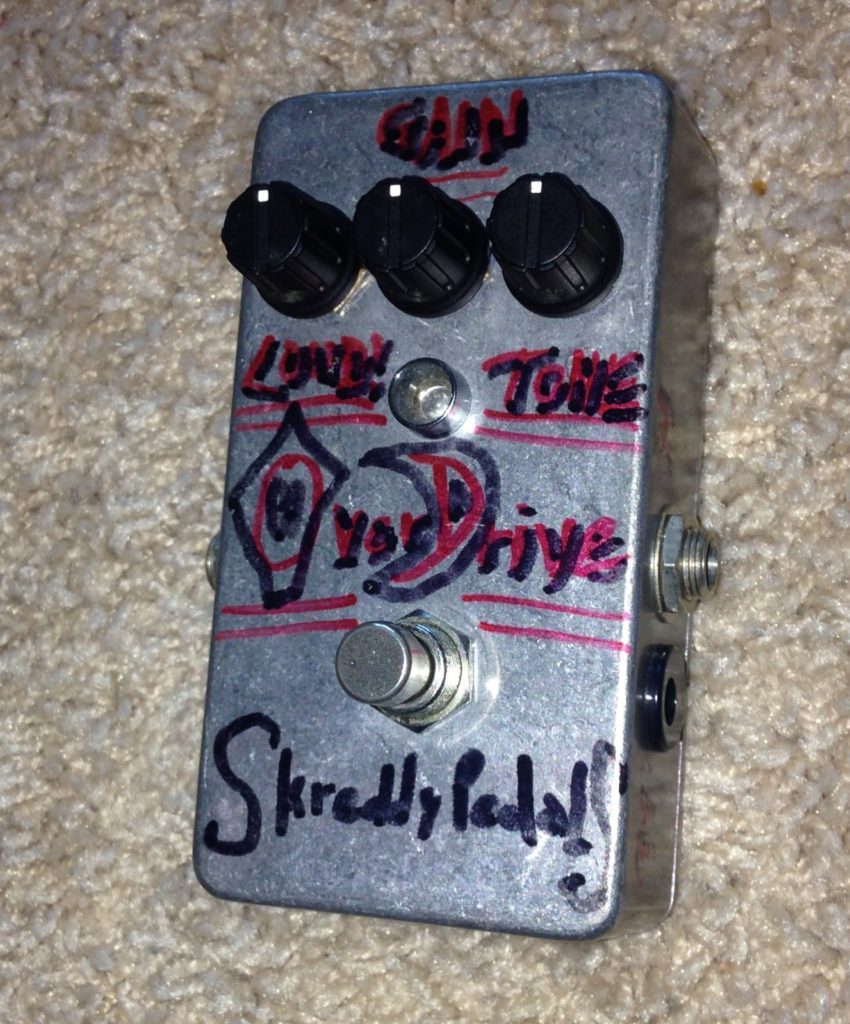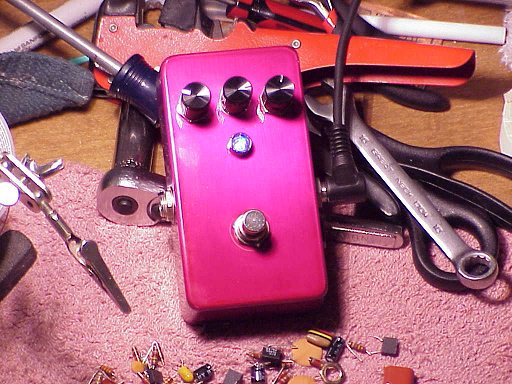Screwdriver (700 +/- made)(ZoSos and Lucky Charms are screwdrivers)(Tonebender derivative? Modded Fuzzface with Treble Booster input?)(released when? – #4 dated 10-10-05)(retired 10-12-11)(A few units got “Smokey Mods” to balance some early treble issues)(How many made?)(Highest known number – )

Marc's Screwdriver origin story (Via TGP):?
"I did have the basic building blocks of a Tone Bender in mind when I designed the Screw Driver. For a long time I had used a homebrew Fuzz Face as my primary dirt. Then I made a Range Master and used that as my #2 dirt. Then I noticed a magic happening when I stacked them. Then I noticed that the Tone Bender schematic uses a similar idea (there are many versions, but 2 of them are like a Fuzz Face and a Rangemaster combined--the two different versions differ mainly in the order in which the building blocks are combined). So my prototype idea was to combine the two into a fuzz and have the order switchable. But playing with the idea opened up lots more areas of inspiration and convinced me I didn't need to worry about switching order. I decided to focus in on the awesome overdrive tones instead of fuzz. Lots of evolution and constant tweaking eventually got me to the Screw Driver in its current form. It still resembles some of the lighter tones of a fuzzface or a tonebender; the kind you get with the guitar volume rolled back."Long story short, the Screw Driver was invented to do 2 things:
1) Get a Pagey sound, but using a Strat
2) Get all those cleanish, in-between tones you could get by using a Fuzz Face with your guitar volume rolled back, only without needing to fiddle with the guitar volume.
The SD doesn’t clean up as quickly or suddenly as you roll down the guitar volume. But that’s kind of the point. With some Fuzz Faces, you are at fuzz on 10, overdrive on 8, and clean on 7. Also, the SD rolls off a bit of treble as you turn down the guitar volume. I actually did not design the SD to work well with the guitar volume but rather to sound exactly how you would want it to sound but with the guitar volume full up. The idea was “just step on it” and not have to fiddle with your guitar volume. (I was having trouble dialing in just the right overdrive sound before the beginning of a song using a fuzz, so I designed the SD to have that sound on tap.)
I did, however, design the HFD and the HOD to work well with both humbuckers and with the guitar volume, since a Les Paul is typically played in terms of varying the volumes on the pickups, and that’s an essential part of designing something to work well with humbuckers.






TGP member thesooze asked: “I’d like to know, in Marc’s words, what the “single best aspect of the Screw Driver and Lunar Module” are…”
MARC answered:
“The Lunar’s input is better suited for humbuckers and cleans up better with the guitar volume. I don’t like how the Screw Driver’s mosfet input sounds congested with humbuckers or how it darkens slightly when you clean up with the guitar volume. I designed the Screw Driver to not need the guitar volume for clean-up, and it was built using my Strat to achieve all it’s target tones; in other words I make Pagey tones with my Strat -> Screw Driver, and I don’t bother playing much with the volume knob when I play my Strat.
When you play a Les Paul style guitar, it’s really part of the whole experience to adjust the volume controls to dial in the tone, and in my experience I generally have the pickup selector in the middle position and rarely have either volume knob full up.
The Lunar Module’s input has zero headroom when using humbuckers. Great for fuzz, but not for cleans or overdrive (like it is with singles).
I love how the Screw Driver’s hybrid fuzz (silicon -> germanium) section creates a proper vintage amp-like distortion with its soft edges and how it gets syrupy when you crank its gain, never harsh. And I love how the Lunar Module gets lots more fuzz and aggression and maintains a more neutral EQ rather than a jangly EQ signature like the Screw Driver (which certainly has its place, ’cause hey; variety is the spice of life).
So I started with the Lunar Module’s input into the Screw Driver’s output section and re-tuned it, both gain-wise and EQ-wise, to work with humbuckers (I’m using my Ibanez SZ520 with vintage Maxon PAF-style humbuckers, which is very close to a ’59 Les Paul sonically and electronically) just as well as both pedals do with my Strat (that has Bill Lawrence L-280S noiseless singles).
Here is a list of changes:
– using Screw Driver’s .047uf input capacitor instead of the Lunar’s 10uf input cap
– limited the overall gain of the input transistor to give it more headroom
– changed the gain control of the input transistor from full-range boost to mid boost
– removed the high-cut from the bass side of the “tightness” control to retain clarity even when in bassy mode
– increased the series resistor on the bass side of the “tightness” control by a great deal so it doesn’t overwhelm the fuzz section with boosted bass and excess volume when in bassy mode–instead just has a very natural sounding flubbiness at full counter-clock-wise and of course a tight, but not overly thin, response at full clockwise (much like the Lunar Module at this end of the range), and a neutral EQ at noon
– decreased the filter cap of the 2nd silicon transistor, by a bit, for better high-end clarity
– increased the output volume so that unity gain with loud pickups is still noon on the volume pot (with the Lunar it would have to be turned up to like 2:00 o’clock if I’m not mistaken)
– different output capacitor to match the openness of the humbucker’s EQ when in bypass
So I ended up with the same clarity and touch sensitivity as the Screw Driver when using single coils has, excellent volume-knob cleanup, neutral and open EQ, and hotter range of fuzz available than the Screw Driver. Such a pleasure to finally be able to play with ‘buckers and hear the same clear string attack and openness into a nice overdrive as it gets straight into the amp (better, even). And the fuzz sustains nice and liquid but not nasty sounding.